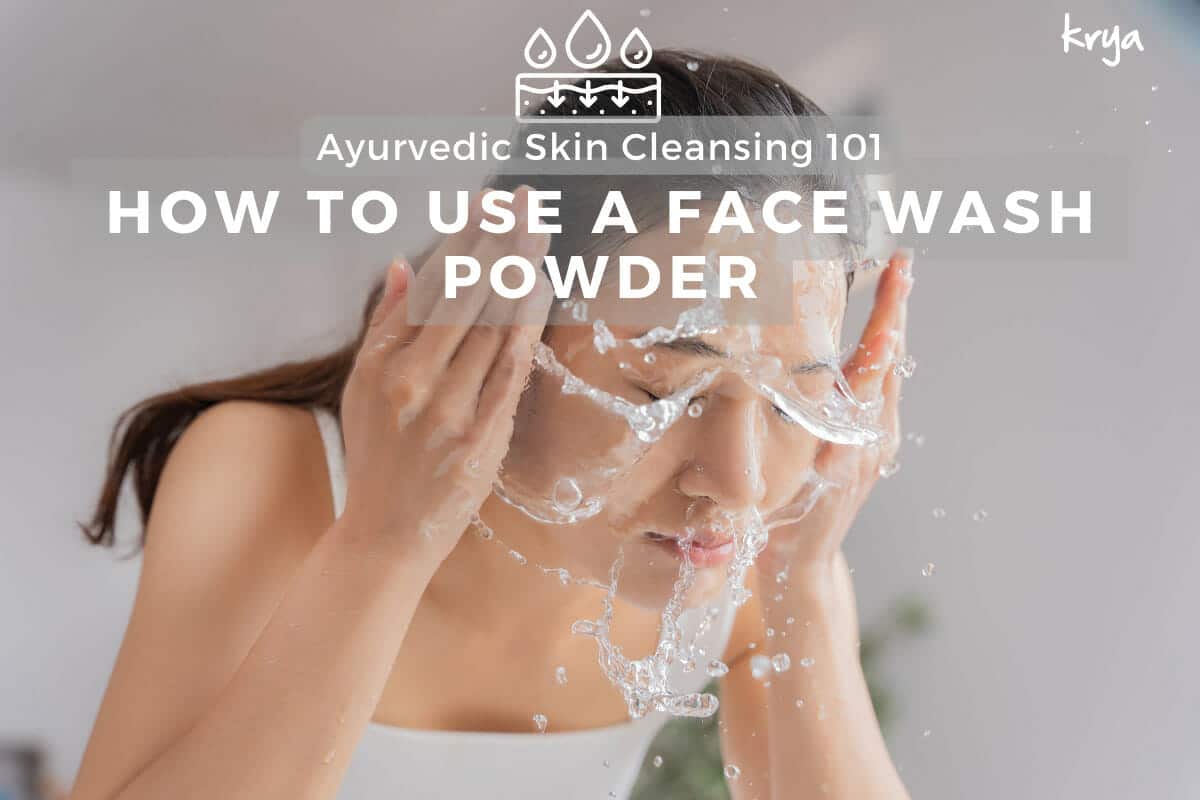This post was last updated on November 19, 2022 by Preethi Sukumaran
A common question we are asked at Krya is how to use a face wash which happens to be a powder. We get this question a lot, as we sell only Ayurvedic powder face washes and body washes. This is a hot new trend in skin care, with everyone from big box retail brands, to high end dermatologists weighing in o the benefits of using raw, natural food ingredients to gently cleanse skin. The commonly quoted example is using fine rice grains or matcha tea powder which is a traditional face cleansing recipe in Japan.
But just as traditional and perhaps even more ancient is Ayurvedic skin care science. In Ayurveda we have used a careful blend of powdered herbs, lentils and grains to gently cleanse skin for millennia now.
The products go behind mere cleansing. We use formulations that can balance Pitta, improve micro circulation, balance oil, reduce minor inflammation and nurture the microbiome of the skin.
Is an Ayurvedic face wash part of classical ayurvedic skin care ?
The classical regimen suggested in Ayurveda is oil application, Mukha lepana (face masks) and cleansing with finely milled cleansing powders This is tailor-made according to need, season and prakriti.
As facial skin was pre-oiled well before a bath, a mixture of cleansing and astringent powders were generally used during Snana to cleanse skin. This was often followed by liberal application of turmeric powder to enhance natural glow, remove excess oil and protect skin from invasion by microorganisms.

The Ayurvedic skin care regimen therefore pays a lot of emphasis on pre oiling of skin as a protective measure to protect skin from weathering and thinning. A wide variety of oils are suggested in the Ayurvedic texts with specific facial oils for different skin types and needs like Kumkumadi tailam, Chandanadi tailam, etc.
This regimen is completely different from today’s skin care regimen. Today’s skin cleansing regimen cleans skin “dry” without pre application of oil. This is much harsher on facial skin which is already thinner and more delicate compared to body skin. Dry cleansing necessitates the need for a separate face cleanser which is processed and formulated differently from body cleansing.
Dry direct cleansing, excess exposure to cold air (through air conditioning), dust, high heat because of the urban heat island effect and high intake of caffeine and processed foods have all contributed to facial skin becoming much more fragile and delicate compared to even 30 years ago.

Our diets have also changed quite drastically – there is an over dependence on exotic fruits and vegetables, reduction in good fats like ghee, and excessive intake of sour, salty and processed food – this aggravates Pitta in the body which can further thin down facial skin.
Therefore, given all these factors, it necessitates the need for an Ayurvedic face wash.
The difference between cosmetic face wash powders and Ayurvedic face wash powders
Many cosmetic companies now have a face wash powder cleanser.
However, these powder cleaners are completely different in ideology from traditional or Ayurvedic powder cleansers. Many of these create a foam in water or transform on the addition of water to give a detergent like cleansing effect. The level of detergency is lesser than conventional liquid or gel based face washes. However, the primary principle at play here is cleansing using a surfactant that deep cleanses skin.
Incidentally many cleansing oil formulations also carry a surfactant. So they also foam or create a thick cleansing gel in water. So the essential point here is to cleanse using a surfactant.
Any addition of herbs or ingredients like rice power, match tea or herbs like liquorice are in the form of extracts, in very small levels, at a claim level only.

A well formulated Ayurvedic face wash powder has a completely different cleansing philosophy. In Ayurveda, we use plant surfactants ONLY sparingly and when needed. It is worth noting that Plant surfactants are extremely mild compared to any synthetic surfactant. If a synthetic surfactant has cleansing ability of say 100, a plant surfactant in its raw form has a comparable activity of between 5- 15% only. This can increase if we isolate or extract the surfactant part alone.
But, Classical texts do NOT suggest extracting and isolating the surfactant portion in plant surfactants like Shikakai, soapberry, etc. The Acharyas opine that this sort of isolation and extraction is unstable and unholistic and view the herb as a whole and not just for 1-2 properties.
Even though a raw plant surfactant is extremely mild, it is rarely used in skin cleansing formulations. This is because skin, and especially facial skin is extremely delicate. While advertisements show us that face washes remove dirt, in reality there is very little “dirt” to remove from facial skin.
So Ayurveda uses only the adsorption method of cleansing by using finely processed lentils and grains and a careful selection of herbs.
The Ayurvedic Acharyas are also well aware of the fine structure of skin. The Srotas are an important part of skin. In fact, facial skin has a much higher concentration of Srotas compared to body skin. Srotas have a capillary like action storing and releasing minute quantities of natural oil, minor acids, mixed with sweat, both to thermo-regulate and to lubricate skin. The Srotas also release these substances to naturally feed and conserve our microbiome which acts as a defensive immune barrier to the whole body.
Therefore, in Ayurveda, the health of Srotas is paramount. Any cleansing substance we use on skin must not interfere with this capillary action of the srotas and support the natural functioning and thermoregulatory action of skin.

Surfactants when over used can dry up and damage the srotas impairing their activities. They also strip the skin of needed natural oils, can irritate your skin and damage the skin cells . In order to properly unclog skin and remove dead skin cells, we need the srotas to be fully healthy and active – unfortunately, synthetic surfactants impair the health of the srotas.
Through a variety of methods like adsorption, attraction and astringency, well formulated Ayurvedic face wash can remove excess oil from skin, deep cleanse the skin, protect Srota health, balance the tri doshas on skin and impart a natural luster to skin.
How to use face wash powder to cleanse skin – basic guidelines
· Cleanse skin only 1-2 times a day with product. Once a day is enough if you are largely at home.
· Use extremely gentle cleansing motion – do not over scrub or leave the product on for too long.
· Always wash your face with cold water or cool water. Warm or hot water is contraindicated as it can cause nerve damage
· If you use makeup, it is important to use a make-up cleansing oil to remove make up before using an Ayurvedic face wash powder as the powder may be too mild to liquefy and remove oil based makeup
· Always follow up skin cleansing with a suitable facial oil to add back moisture that was lost during cleansing.
· Dont touch your face or pick at it during the day. This can aggravate pitta, cause minor inflammation and redness in skin
Dont exfoliate your skin often – in fact if you want to follow a classical ayurvedic routine, avoid this altogether
How to use a face wash in the correct Ayurvedic way – step by step instructions
1. Pick a face wash that suits your skin type
Gently splash your face with water. The water you use should be clean and cool. Make sure you wet your entire face thoroughly.
2. Using a clean spoon, take ½ a teaspoon of Ayurvedic face wash powder. We do not need too much product to cleanse facial skin.
3. Add a few drops of water to make a thick paste. Use a tiny cup to make this paste – if you do this directly in the palm of your hand as shown by many beauty influencers, you might end up adding too much water or wasting the product.
4. Begin washing your face by applying the product on moist / damp skin using gentle circular motion to clean your face. Do not scrub too hard or for too long as facial skin is extremely gentle and delicate.
5. Avoid the area around the eyes and any broken or inflamed skin.
6. If you have cystic acne or inflammation, make sure you are using the right product for your skin type. Even if you use a well-researched anti acne Ayurvedic face wash powder, remember to avoid scrubbing the acne/inflammation. On these areas, use a gentle touch and apply the product like a face pack gently covering the acne with the product. Do not scrub or rub.
7. Wait for 10 – 15 seconds
8. Gently wash your skin and rinse out the product carefully.
9. At the end, rinse out your mouth well and hold cool water in your mouth. Simultaneously gently rinse your eyes in cool water.
10. Dry your face by gently patting it with a soft cotton towel until it is damp, but not completely dry
11. While the skin is still damp, apply 3 drops of your favorite Ayurvedic facial serum. Pat the serum in gently in an upward direction.
12. This completes your Ayurvedic face cleansing + care routine
13. We recommend washing your face 1-2 times a day. Twice if you step out and are exposed to dust and pollution or if you wear makeup.
Do not use makeup atleast 1-2 times a week to allow your skin to breathe well.
Now here are some frequently asked questions about using an Ayurvedic powder face wash & their answers.
What is the difference between an ubtan and an Ayurvedic face wash powder?
An ubtan is formulated primarily for body skin. It is also formulated to be used on oiled skin and not on dry skin. For these 2 reasons, an ubtan is unsuitable for facial skin. The granular size and herbs used may be unsuitable for facial skin. As it is designed to cleanse oiled skin, it could be slightly drying for unoiled facial skin.

An Ayurvedic face wash powder, on the other hand is primarily formulated for facial skin. It is gentle, delicate and is designed for different skin types. It is NOT suitable for bathing for the overall body but it is very good for facial skin.
Should I use a different face wash for day and night?
This is not necessary from an Ayurvedic point of view as we are only concerned with the basic nature of your skin and your skin type. This does not vary between day and night, so the same Ayurvedic face wash powder can be used for both occasions.
What is the difference between an Ayurvedic face wash powder and a scrub to wash your face ?
An Ayurvedic face wash powder is not a scrub. A scrub is generally designed for exfoliation and certain materials like nut shells, astringent substances like coffee beans, fruit peels, salt or sugar are used in the formulation. There is no major concept of exfoliation per se in Ayurveda.
We have dry skin brushing or gharshana which is part of panchakarma treatment for Kapha disorders. But deliberate facial exfoliation is not suggested in Ayurveda.

We treat the facial skin as very delicate, so care is taken not to abrade or cut the skin in any way. We are also concerned about srota health which can get damaged if we exfoliate unnecessarily. So an Ayurvedic face wash powder is different from a scrub / exfoliant.
My dermatologist says that Ayurvedic face wash powders are too exfoliating and not a good facial cleanser .
This depends upon how the Ayurvedic face wash powder has been formulated. But just to remind you, Ayurvedic choornams have been used safely and with great results for millennia in the Indian sub-continent. Similarly, other cultures like Japan, china, Korea and many traditional communities have successfully used a combination of herb, fruit and clays and seed powders to cleanse skin. Whereas synthetic face wash products are under 50 years old.
Of course, when we formulate and process an Ayurvedic face wash powder, the manufacturer should take great care in ensuring the right ingredients are taken, they are processed finely and the final output is delicate, soft and does not irritate skin in any way. So it is important to find the right product which have been made carefully.
If that is done, Ayurvedic face wash powders are extremely suitable for daily use even for delicate facial skin.
Can I use an Ayurvedic face wash powder while pregnant?
Yes, you may.
However, please ensure you choose products from a good company that is transparent about its process and also shares the ingredients that go into the formulation. They should also have done their research and let you know that they have used pregnancy-safe herbs and ingredients.
Can I use an Ayurvedic face wash after applying a face scrub / face pack?
This is NOT advisable. Face scrubs can be harsh on skin. Face masks are also deep cleansing and toning. Using an Ayurvedic face wash powder after these 2 treatments may dry out skin. Instead, you may cleanse your skin before using a face mask.
Pre cleansing is not required before using a scrub. However, we suggest using face scrubs minimally or skipping them in your skin care routine.
I have sensitive skin . Can I use an Ayurvedic face wash powder?
Yes, you can, as long as you pick the right ayurvedic face wash powder. Look for a product that is formulated for pitta type skin or is labeled for sensitive skin. The product should be extremely finely processed.
I have dry or sensitive skin. How to use a face wash correctly?
The face wash method is the same as we have outlined above. Please make sure you choose the right face wash product for vata-pitta type skin. Additionally, you may add a few drops of cows milk (boiled, without cream) to your face wash paste once in 2-3 days.
I have clogged / oily skin. Do I need to wash my face twice a day?
This is not necessary. we suggest washing skin twice a day if the skin has been exposed to outside dust, or pollution or if make up has been used. If not, once is enough. Do remember that you should choose the right face wash that is suitable for clogged skin.

My foaming facial cleanser says it is gentle and natural. why should I switch to an ayurvedic face wash powder?
We have outlined the reasons why a foaming facial cleanser cannot be natural. As for gentle, as this type of skin care product uses the principle of detergency and a mild surfactant to clean skin, it is much harsher than the principles of adsorption, astringency and dosha balance an ayurvedic facial choornam is formulated by. Please do try one to see the difference for yourself. Over time skin is healthier, more balanced and works better functionally with an ayurvedic face wash powder.
How should I use a face wash powder as part of a double cleansing routine?
Yes, you can use an Ayurvedic face wash powder after using a cleansing oil as a part of a double cleansing routine. We suggest using a natural cleansing oil if possible as synthetic cleansing oils and balms can sometimes contain drying surfactants especially if they are oil to foam format. You may explore our natural cleansing oils here.
What is the correct way to wash your face ? What is the correct way to rinse your face?
We have given detailed guidelines above explaining how to use a face wash. Please do read it. in addition please watch this video which gives the step by step process.
Should I use lukewarm water to cleanse skin if my skin is oily or clogged? What is the right water temperature to use ?
Ayurveda suggests using ONLY cool or room temperature water to clean skin. Clogged skin should be unclogged with the right herbs and base and NOT with hot water. Hot water destabilised the facial nerves and can also impair eye sight. So avoid warm or luke water while washing your face.
Is micellar water a good addition to my skin cleansing routine ? It seems mild and similar to washing the face with water.
Micellar water is technically a very diluted surfactant suspended in water. When you add surfactants to water they form small clusters called micelles. So Micellar water is really a very very diluted face wash. As water forms the largest part of the product it is touted as a natural, clean and greener way to cleanse skin . However in reality we are STILL using synthetic surfactants to clean skin.

Micellar water is unnecessary and not really a great addition to your skin care routine, especially if you are trying to go ayurvedic and natural.
How to find out if my Ayurvedic face wash is actually Ayurvedic and natural?
Let’s first look at some basic formulation principles to check if the face wash powder you are looking at is both Ayurvedic and correctly formulated:
· The product should not foam or change format drastically. If it changes from powder to foam or from say oil to foam it is not natural or Ayurvedic
· The product should be formulated on the basics of cleansing by adsorption, astringency and maintaining vata dosha balance. So it should preferably NOT contain any surfactant even a plant based surfactant
· The product should have many variants to suit different skin types. Ayurveda never recommends a single product for all prakritis. Different skin types have different tolerance to both grain size and ingredients. For example, Pitta skin tends to be sensitive in general. We need to formulate a very finely processed product and also include pitta balancing ingredients. Sun burned skin tends to have pitta and vata aggravation – so we cannot use astringent and drying type of pitta herbs.
· Water based pastes gels or liquids could contain preservatives and other chemical additives. These should be avoided as they are not natural and not Ayurvedic either.
· Avoid products which are labelled as scrubs – they could be too exfoliating and harsh for daily use
How to choose the best face wash powder for my skin type / prakriti?
1. For oily skin prone to occasional acne, white heads and pimples – choose a pitta balancing face wash that uses pitta balancing astringent herbs like Usheera, Dadima, Nimba, Clays, etc. The product should be finely processed, and must feel cool and comfortable on skin.
· In Krya, we have the Krya Classic face wash which is suitable for this skin type
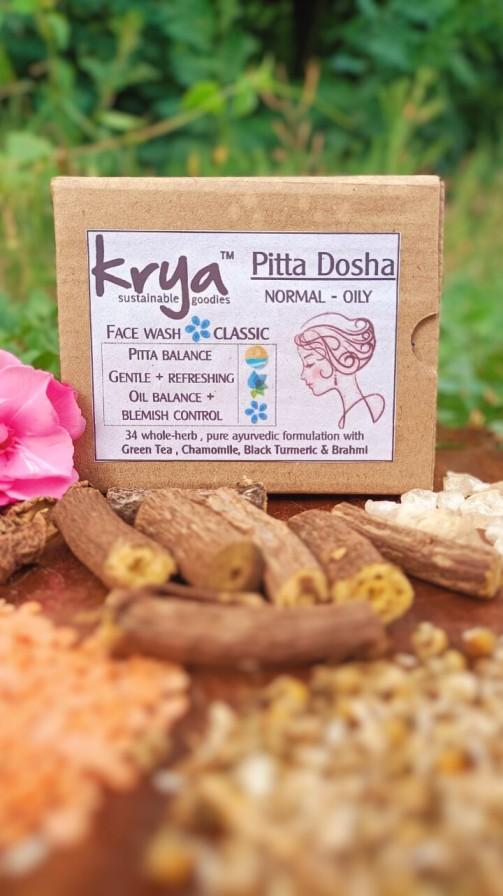
Classic Face wash for Oily Skin | Balances Sebum . Clarifies Skin.
2. For oily, clogged acne prone skin ending towards cystic acne, and pus filled whiteheads – choose an extra gentle pitta AND Kapha balancing product. The product should contain pitta balancing AND oil controlling astringent herbs. The herbs should also deep clean srotas. The product should be extremely fine and delicate without any oversized particles. Avoid products with potential skin irritants like Besan. If turmeric is used, varieties like White turmeric or Wyanad turmeric should be preferred as too much of regular turmeric is Hot and can trigger skin irritation
· At Krya we have an Adult anti acne face wash.
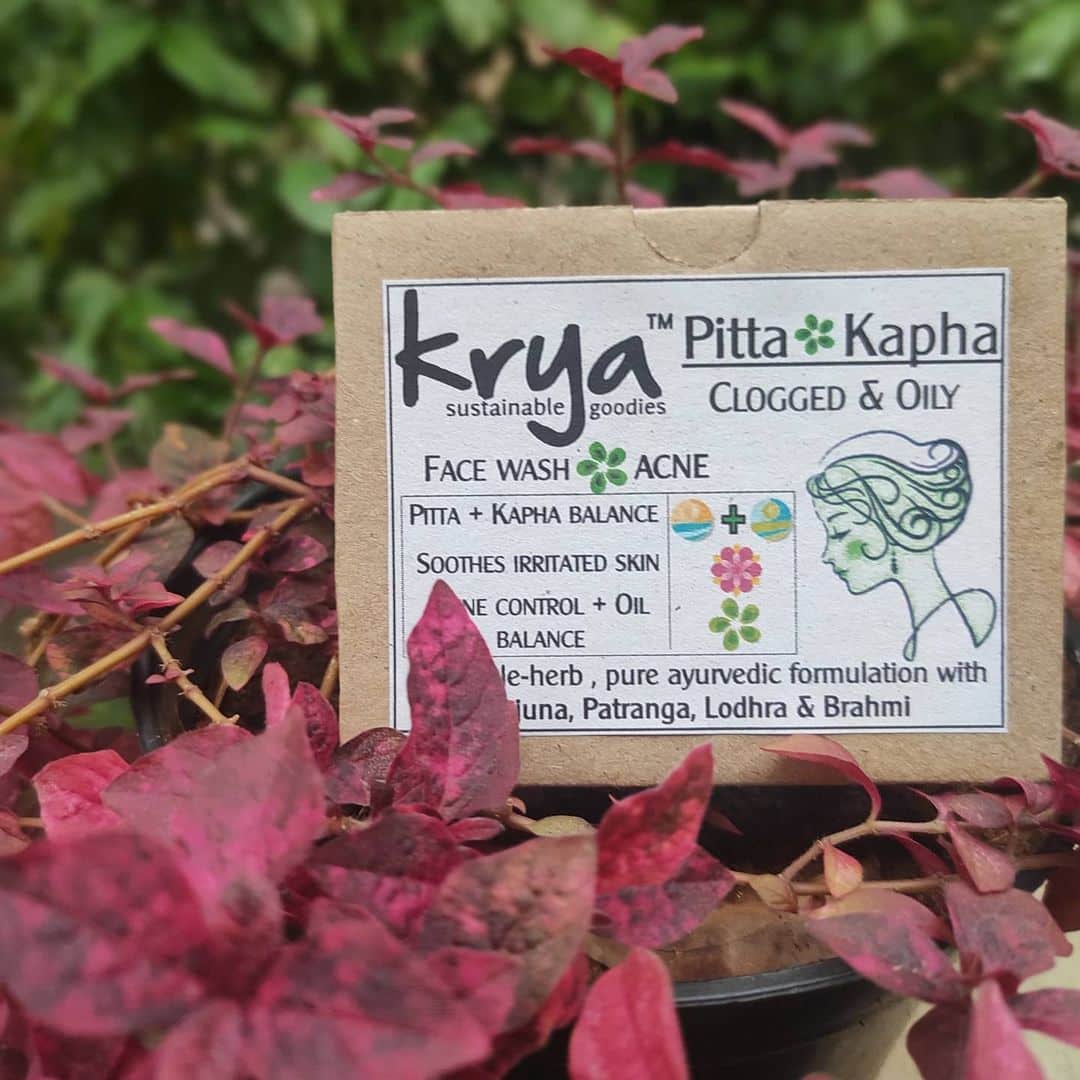
Krya Anti-Acne Face Wash (100 gm)
3. For skin that is dehydrated and tanned due to high sun exposure – choose a face wash that uses pitta balancing herbs which are NOT too astringent or drying as tanned and burned skin is dehydrated also. So we need to balance Pitta and vata and use nourishing, healing herbs like Yashtimadhu, Bala, etc.
· At Krya we have the After Sun face wash
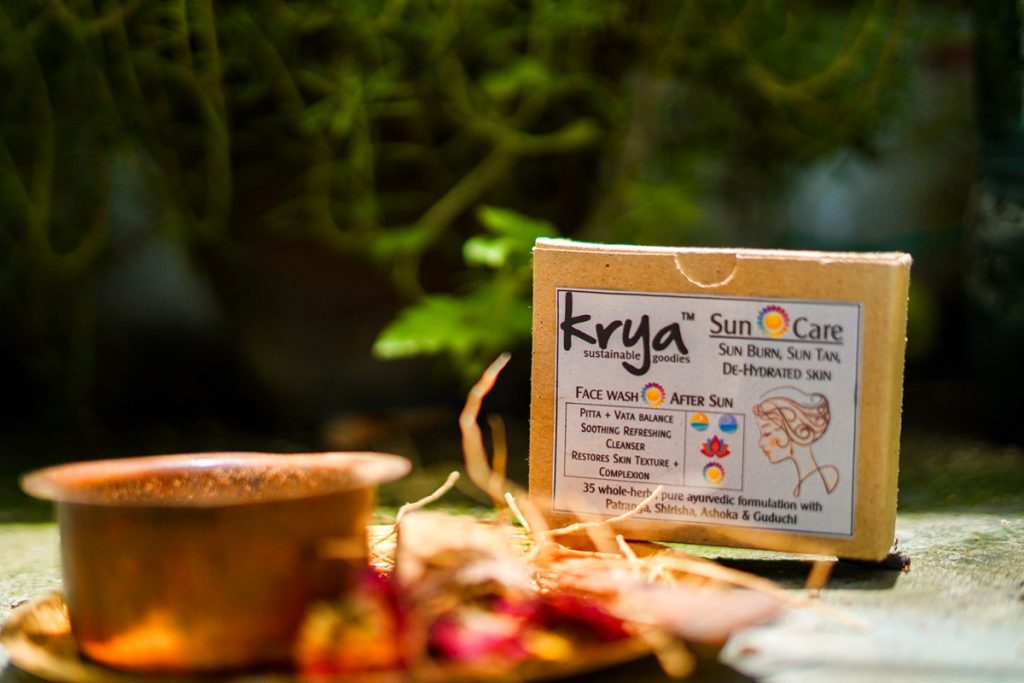
Krya face wash : After Sun – for sun tanned, sun burned, dehydrated skin
4. For skin that tends to be dry and dehydrated, we need to choose vata balancing herbs. Here cleansing should be done by providing vata balance through micro circulation boosting, unctuous and tejas improving herbs
· At Krya we have the Moisture Plus face wash
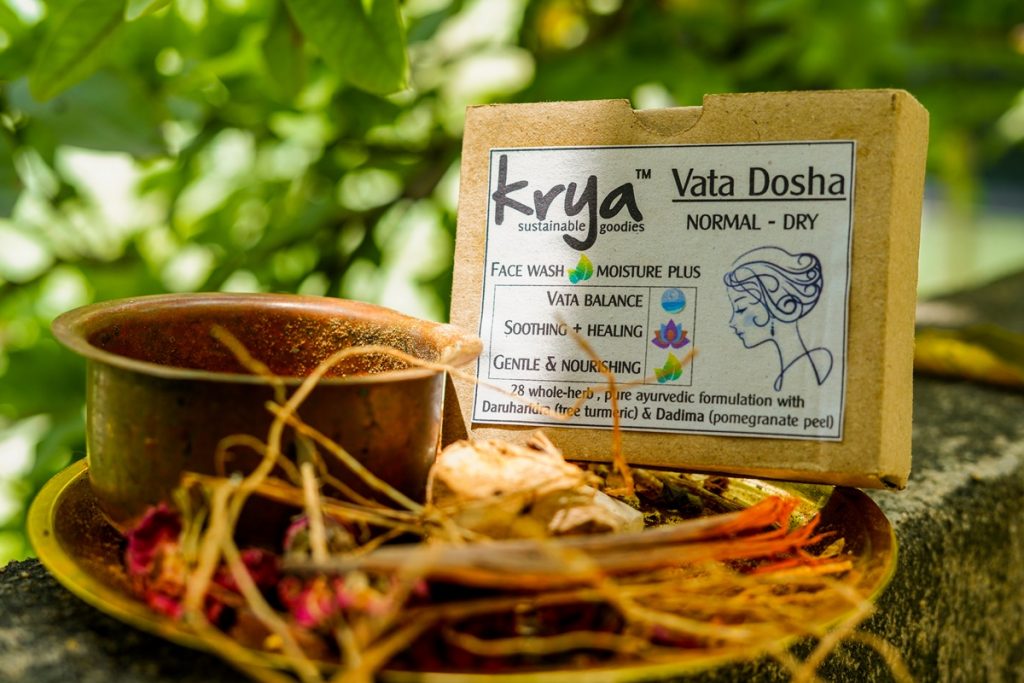
Krya Moisture Plus Face wash powder – gentle face wash for dry skin (vata prakriti)
5. Men’s skin has a slightly different structure compared to Women. It is thicker compared to Women’s facial skin and has a much higher concentration of srotas producing oil and sweat. The rehydration capacity of Male Stratum corneum is higher compared to women’s skin. However, Men’s skin loses hydration much more rapidly compared to women’s skin post 40. Keeping these factors in mind, a Men’s face wash should contain (for younger skin), good Pitta balancing and oil balancing herbs.
The product can contain a higher amount of astringent herbs compared to Women’s skin products. We can also focus on using a greater number of Pita balancing herbs in this formulation like Usheera, Lodhra, Ananthamoola etc. Depending upon occupation, Men’s skincare can also use Vata balancing herbs if the skin is aged, or there is high dehydration due to alcohol consumption, sun burn etc.
· At Krya we have the Men’s Classic face wash for Normal to oily skin with imbalanced Pitta dosha.
6. Teen acne – Teen acne is extremely intensive with high likelihood of hormonal cystic acne. For this acne we have to formulate a more intensive product that balances Pitta and Kapha based secretions and also works on reducing acne size, clarifies marks, etc. This product should be formulated differently from adult acne as the conditions leading to acne are different.
· At Krya we have the Teen Anti acne face wash for this skin.

Krya Teen Anti-Acne Face Wash powder
To sum up: how to use an ayurvedic face wash powder correctly
In this article, we explored the science behind the simple act of cleansing your face. we learned the differences between an ayurvedic face wash powder and synthetic face wash powders. We also learned the art of properly cleaning your skin and how to take care of your face the right way using a gentle ayurvedic cleansing routine.
The skin on your face is not inert – it houses important organs, is the gateway to the eyes, nose and brain and contains a large number of blood vessels and nerve endings. So a product should not merely aim to keep the face clean. It should respect and understand this complex area and work along with it.
Cosmetic skin care is getting superficially more and more complex and sophisticated. Yet many of us yearn for a gentler, more real and more natural skin care routine that is founded in real traditional science and wisdom. Ayurvedic skin care provides those yearning for this, step by step guidance, a solid set of principles to understand this routine and also suggests a wide variety of herbs , and techniques that dont just result in a clean face.
In this post, we learnt how to use face wash powder to soothe the tri doshas, improve micro circulation and balance skin. Skin is helped to get healthier with its own unique luster, in a harmonious and simple way.
Advertisements and influencers can tempt us to think more is better. We are asked to use specific AM PM products, use micellar water and other such extra products, exfoliate incessantly and have a complex daily face care routine.
We hope this article gave you solid ayurvedic science and an explanation to help you keep your skin care routine real, yet effective. if you have any questions on this article or want our help selecting the right ayurvedic face care products, do get in touch.

